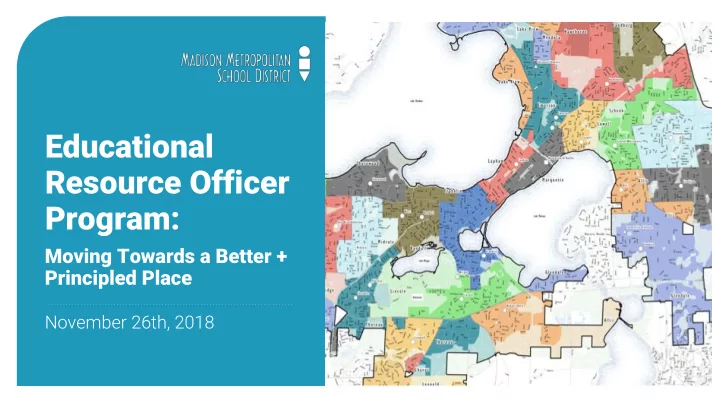

Educational Resource Officer Program: Moving Towards a Better + Principled Place November 26th, 2018
THE CHARGE Identify ways to improve the current state of our Educational Resource Officer (ERO) Program ERO Ad Hoc Internal MMSD Committee Work Group Administration Patrice Hutchins : Dean, West High School Marques Flowers : Dean, Memorial High School Alex Thompson : Assistant Principal, East High School Johnnie Milton : Multicultural Service Coordinator, La Follette Joseph Balles : Coordinator, Safety + Security Ricardo Jara : Chief of Staff
THE APPROACH ● Envisioning a holistic and team approach to fostering safety and wellness throughout an entire school community ● Strengthening partnerships among community agencies and groups to expand and deepen restorative services to youth ● Maintaining a critical eye on our work and ourselves, with the aim of always doing better in service to school communities
EXAMINING THE LANDSCAPE Time was spent examining reports, recommendations, and realities: MMSD ERO Data ● ● ERO Ad Hoc Report OIR Report + MPD Response to OIR Report ● ● ACLU: Bullies in Blue Historical development of EROs in MMSD ● ● Narratives of the realities of policing in the United States and in schools
SEEKING PERSPECTIVES Time was also spent listening to concerns, ideas, and everything in between re: the current ERO program: Students: Relationship-building among EROs is valued; their presence can also feel ● threatening. ● School Staff: Clear systems and shared commitment to students is key. Families: Gun violence is a real threat; EROs provide a sense of security. ● ● EROs: Much more than a police officer; shared commitment to racial justice. ● City and County leaders: The status quo is not acceptable. ● Community Groups : Resources could be better used elsewhere (e.g., social workers).
BELIEFS ● The status quo is not acceptable. Belonging is at the heart of this conversation and is our key ● aim. Our actions should always be grounded in our Core Values. ● The work of creating the conditions for all youth to thrive, ● particularly our youth of color, is a responsibility that belongs to the entire community. Individual, institutional and systemic racism are real - the ● entire community has a responsibility to confront it.
THE PATH FORWARD > Holistic approach to safety + wellness > Strengthening partnerships > Challenging assumptions * Recommendation from ERO Ad Hoc Report
HOLISTIC APPROACH TO SAFETY + WELLNESS Invest in Youth of Color: 1. Invest in current and emerging leadership development, career development, and identity-affirming programming for youth of color. 2. Invest in the expansion and strengthening of restorative practices like youth court*, including increasing the involvement of families and the community in these practices.
HOLISTIC APPROACH TO SAFETY + WELLNESS Reconceptualize the entire safety and security system at each school, with a focus on holistic student safety and wellness: 1. Begin with the role of safety and security staff (SSAs), with an eye towards empowering these individuals to serve as peacekeepers, mentors, and student advocates.* 2. Explicitly define and standardize the role and expectations of EROs, particularly their engagement with schools leaders, staff, and students.*
STRENGTHENING PARTNERSHIPS Strengthen partnership with city, county, and community organizations, with an eye towards keeping youth out of the criminal justice system 1. Explore incorporation of the voice of youth and families into the selection, assessment, and retention of EROs* 2. Expand the public ERO report using qualitative and quantitative data analyzed through a racial equity lens*
STRENGTHENING PARTNERSHIPS 3. Further develop critical competency (e.g., challenging implicit racial bias, trauma-informed care, adolescent development, for instance) among EROs and all safety staff* through courses co-developed with MMSD and community organizations. 4. Explore methods for sharing ERO costs, and use savings to invest in identity-affirming and leadership development programming for youth of color, and restorative justice programs.
STRENGTHENING PARTNERSHIPS 5. Provide EROs the flexibility to: ○ Use soft uniforms ○ Remain at specific school assignment beyond the current limit.*
CHALLENGING ASSUMPTIONS Encourage innovative approaches to fostering school safety and wellness 1. Commit to the exploration of new approaches to fostering safety and wellness and the creation / re-conceptualization of roles to support this new system. 2. Integrate students, staff, families, and community members into the design process.
MOVING FORWARD We must do better.
Q + A
Recommend
More recommend